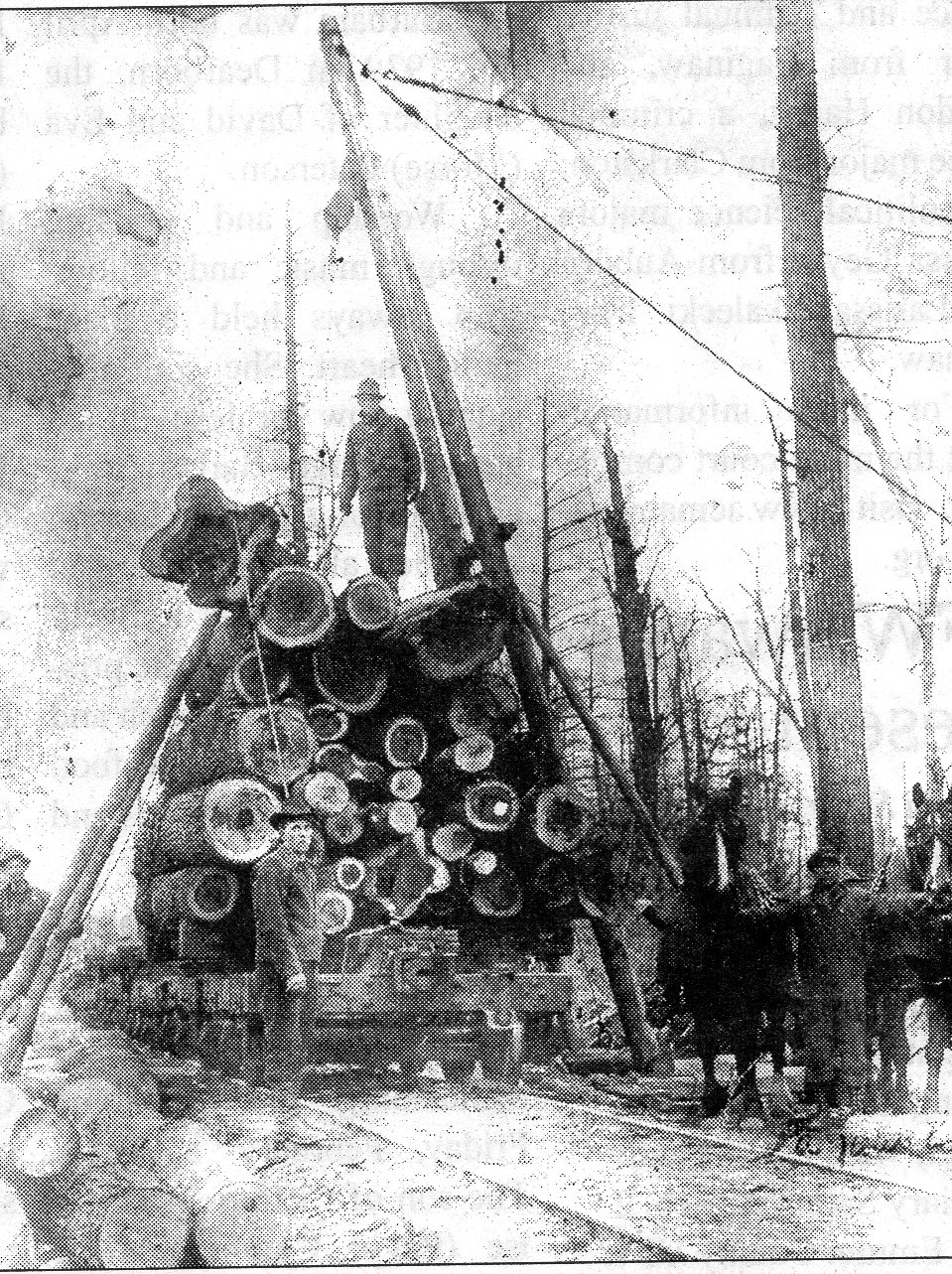
of Pioneer Settlers of Allis
Part VII
Submitted by Nute Chapman
From Onaway Outlook February 8, 2013

 |
of Pioneer Settlers of Allis Part VII Submitted by Nute Chapman From Onaway Outlook February 8, 2013 |
 |
CAPTION : LUMBERMAN CLYDE ALLIVOID, standing on top of a load of logs. Wallie Newsted is standing on the right with his
team of horses and Herb Stock is standing in front of the load of logs.
 Unpublished by Oscar Adelbert Roberts and edited by daughter Ruth (Roberts) Schmidt Part VII
Unpublished by Oscar Adelbert Roberts and edited by daughter Ruth (Roberts) Schmidt Part VII
We were driving to several points of interest on the Au Sable River including the "rollways" and we're now at
the Lumberman's Monument, which was three life-size figures in bronze, each holding the tools he worked with
in the lumbering days.
Now some of our group were anxious to move on. "Not so fast, my son, I am reading what is written here." "But Dad,
you have had time to read those few lines a dozen times." "Yes, yes, son. You're right. But it takes much longer to read
between the lines." "Alright Dad, what does it all mean?"
Well, at one time this was a solid forest of white pine, the finest on the land. And then the loggers moved in. But
before any timber was cut, this land at government expense was surveyed and trails blazed, dividing it into townships and
sections.
The tall man in the center looking at his compass was known as the land looker, cruiser or locater, who would have
been employed by the large lumber companies to locate and estimate the timber value of any tract of land that they wished
to purchase.
The man on the right with the axe and crosscut saw represents the logging crew of almost any number of men up to several
hundred, if the tract was a very large one.
These men were then divided into smaller crews. A typical saw crew usually consisted of three men, a timber "fitter" who
determined which way a tree was to fall and by chopping a notch on that side, becoming so skillful that a tree would fall
exactly where he wanted it. The two sawyers cut the tree down with crosscut saws. When the trunk was nearly sawed off, there
arose a great shout of "Tim-berr," and the great tree came crashing down. Then the other sawyers cut them into logs.
A skidding crew consisted of a strong team of horses, a teamster, and his "swamper" whose duty was to make roads to the
logs which were then "skidded" or hauled onto a skidway where they could be "decked" into great piles 10 to 12 feet tall.
"But Dad, how could they pile such huge logs that high?" "I'm coming to that, son." The decking, also called loaders or
cant-hook, men were the best paid men in any camp. This crew was made up of one or two men "rolling down," one or two "sending
up," one or two top loaders or "sky peaks," another pulling chain, and a cross-haul team and teamster.
A decking-line, which was really a light chain made of the best 60,000 pound tensile strength steel, was placed on top of the
skidway. On one end was a swamp hook, which was driven or set on the top of the pile after the chain had been wrapped around
a log in such a way that the team hooked to the other end could roll the log up the slanting skids. A good cross-haul team
of horses were so well-trained that they knew what the top loaders wanted as well as their teamsters did. "Head" meant go,
"Down" meant back down, "Ance up" meant go ahead one step. And at the word "Back" the teamster better trip the hook instantly,
for that team would be on their way back to the skidway, like a couple of jack-rabbits, and turned around all ready to do it
all over again.
When the snow came, these same logs were loaded on log sleighs, with the beds usually 12 or 14 feet wide and hauled to the
riverbank where they were "decked" once more or just dumped over the bank of the river, as at the rollways.
When spring "break-up" came, part of the crews would go back to their farms for the summer. But the "dyed in the wool"
lumberjacks stayed on for the "drive" and were then referred to as "River Drivers" or river hogs.
Now, that man with the peavey and caulked boots represents the "River Driver." As soon as the river is free of ice, the men
would break the rollways and a million feet of white pine would be on the way to the great sawmills at the river's mouth.
This was hard, exciting, and very dangerous work. When the logs would "jam" at a curve of the river, it was the job of these
river-hogs to go onto the piles and break up the jam, very dangerous. Some of the men would compete at log rolling contests,
just for the excitement of it. It's a life that is long gone.
-From The Onaway Outlook, February 8, 2013, p. 3.
Retyped by J. Anderson.